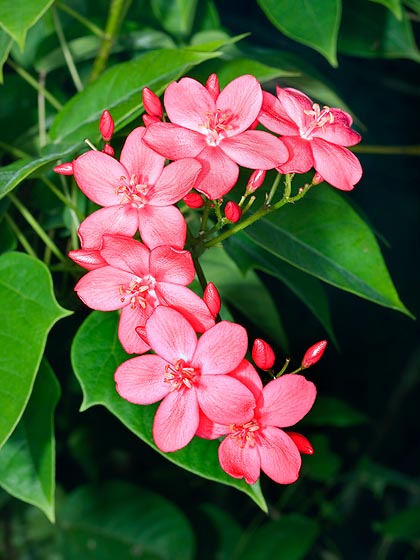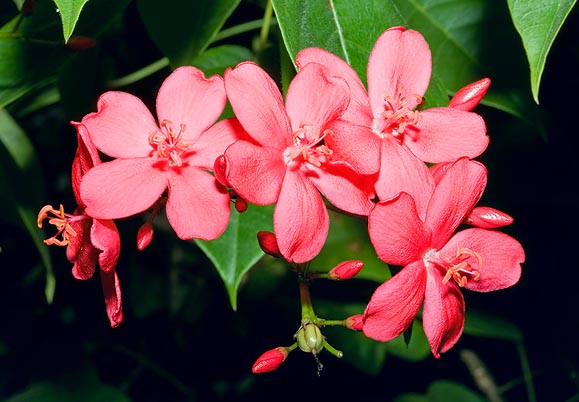Family : Euphorbiaceae

Text © Pietro Puccio

English translation by Mario Beltramini

The Jatropha integerrima is a 4 m ornamental shrub © Giuseppe Mazza
The name of the genus comes from the combination of the Greek terms “iatrόs” = doctor and “trophé” = food, with reference to the medicinal properties ascribed to the species belonging to the genus; the name of the species is the superlative of the Lain adjective “integer” = whole, entire, with reference to the entire margin of the leaves.
Common names: peregrina, spicy jatropha (English); epicar, guitare, jatropha-fleur, médicinier, médicinier-guitare, pignon d’Inde epicar (French); peregrina, flor roja, pasqualino, yuramira (Spanish); Korallenbaum, Korallenpflanze, Korallenstrauch, Peregrina-Strauch (German).
The Jatropha integerrima Jacq. (1763) is a shrub or a small evergreen tree, up to about 4 m tall, even if, when cultivated, keeps lower.
The leaves are alternate, 5-15 cm long and 3-8 cm broad, of an intense glossy green colour, of variable shape, usually entire, ovate or elliptic with acute tip, at times variously lobed.
The flowers, usually united in terminal cymes on a 5-10 cm long peduncle, are unisexual (male and female) and present on the same plant, of scarlet red or coral colour with a diameter of about 3 cm, and are abundantly and continuously produced most of the year.
The fruits are sub-globular, dehiscent (which spontaneously open when ripe) capsules with three little evident lobes, of about 1-1,3 cm of diameter and length, the seeds are ovoid, about 8 mm long, of pale brown colour with blackish dots.
It reproduces by seed, which is to be kept in water for one night before being placed on the ground in order to facilitate its germination, and easily by woody cutting in spring-summer.
It is an easily cultivable species as it does not require too many attentions, and is diffused, for ornamental purposes, in the tropical and subtropical zones, where it often tends to become spontaneous. It may be cultivated only marginally in the warm temperate ones, as it does not bear temperatures just below 0 °C.

Showy flowers, but all plant is toxic, especially the seeds © Giuseppe Mazza
All the parts of the plant are considered as toxic, in particular the seeds, therefore its presence in places frequented by children must be avoided; the latex may cause irritation of the skin in particularly sensitive individuals.
Synonyms: Jatropha hastata Jacq. (1763); Jatropha acuminata Desr. (1797); Jatropha pandurifolia Andrews (1802); Jatropha coccinea Link (1822); Adenoropium integerrimum (Jacq.) Pohl (1826); Adenoropium pandurifolium (Andrews) Pohl (1826); Jatropha diversifolia A.Rich. (1850); Jatropha pauciflora C.Wright ex Griseb. (1865); Jatropha diversifolia var. pandurifolia (Andrews) M.Gómez (1894); Jatropha diversifolia var. pauciflora (C.Wright ex Griseb.) M.Gómez (1894); Jatropha moluensis Sessé & Moc. (1894); Jatropha glaucovirens Pax & K.Hoffm. (1910); Jatropha pandurifolia var. coccinea (Link) Pax (1910); Jatropha pandurifolia var. latifolia Pax (1910); Adenoropium hastatum (Jacq.) Britton & P.Wilson (1924); Jatropha integerrima var. hastata (Jacq.) Fosberg (1976); Jatropha integerrima var. coccinea (Link) N.P.Balakr. (1982); Jatropha integerrima var. latifolia (Pax) N.P.Balakr. (1982).
→ To appreciate the biodiversity within the family EUPHORBIACEAE please click here.
